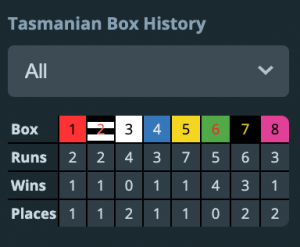In most greyhound races the field is left with only a few winning chances within seconds of the boxes flying open.
Some dogs are noted railers while others prefer to race wide on the track but in either case the box draw is crucial to winning chances.
In this piece of FORMPLUS education we take a look at how replays, speed maps and box data can be used to work out whether a greyhound is drawn favourably and subsequently if they are a strong winning chance for a particular race.
Box draws
Box history for all greyhounds are available by clicking on the profile for a particular runner.
Headspace trained by Debbie Cannan was an example of a dog that liked to race wide and she only missed a placing twice from 14 runs when she drew the six, seven or eight box (picture on the right).
A great example of her racing manners was in March last year when drawing box seven. You can see from the head on replay that she didn’t head towards the inside rail like the rest of the field, racing far outside the other runners before crossing towards the first bend.
While clearly better placed when drawing towards the outside, Headspace still had a reasonable record when drawing closer to the inside rail although her chances were then dictated by the speed of the runners drawn around her.
Drawing the red box in Launceston she looked poorly drawn but the FORMPLUS speed map indicated that she was quicker early then the dogs immediately to her outside. Despite her tendency to want to run away from the inside, she had the speed to avoid being crossed and scored a comfortable win.
Speed Map
The map is vital in all three racing codes but perhaps none more than greyhound racing where the length of the race makes it hard to overcome any mistakes.
Tasracing greyhound early speed maps are available for all races and are formulated using previous first sectionals.
Looking at the below race over the 515m in Launceston last year, the speed map indicated the early pace would come from Lily Lola drawn in box four and Vintage Dancer from box six.
They both jumped well with Vintage Dancer wanting to cross to the inside but the problem for him was that Lily Lola is a wide runner and their bumping dual put an end to their respective races.
Process of elimination
Sometimes a dog being drawn poorly is not only a hindrance to its own winning chances but also to the opposition.
In the below race at Devonport in November last year, the seven dog Hardaway Zoe was the $51.00 outsider of the field, drawn poorly as a dog that loves to find the inside rail.
Her desperation to cross the field and find the rail hindered almost all the opposition with the exception being the only dog drawn to her outside, Hartley Kris who drew the pink box.
Conclusion
The puzzle of doing the form for the greyhounds isn’t an easy one but the tools are there to help find a winner.
Head on replays are available from most starting points in Launceston, Devonport and Hobart and can help learn more about the racing tendencies of dogs as they leave the boxes.
This information can be combined with the box data and speed maps to provide a clearer picture of which dogs are likely to be favoured in the race.
View previous FORMPLUS education pieces:


